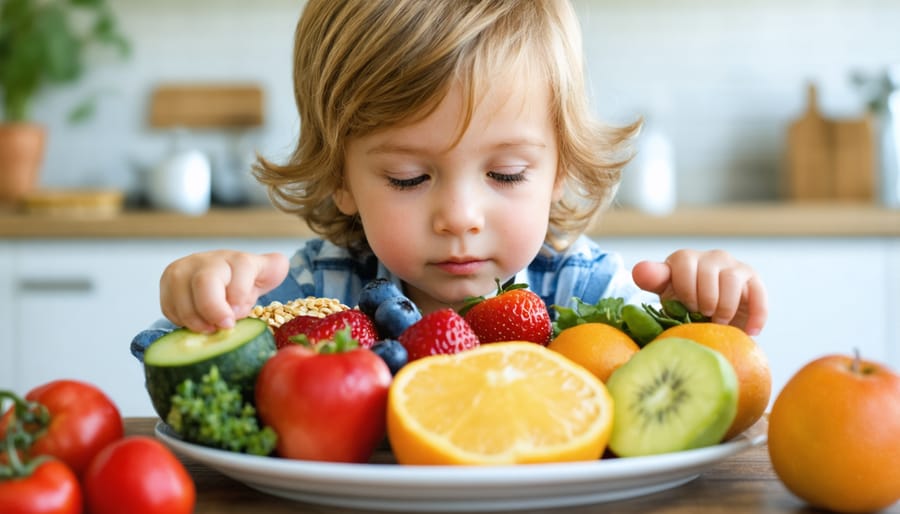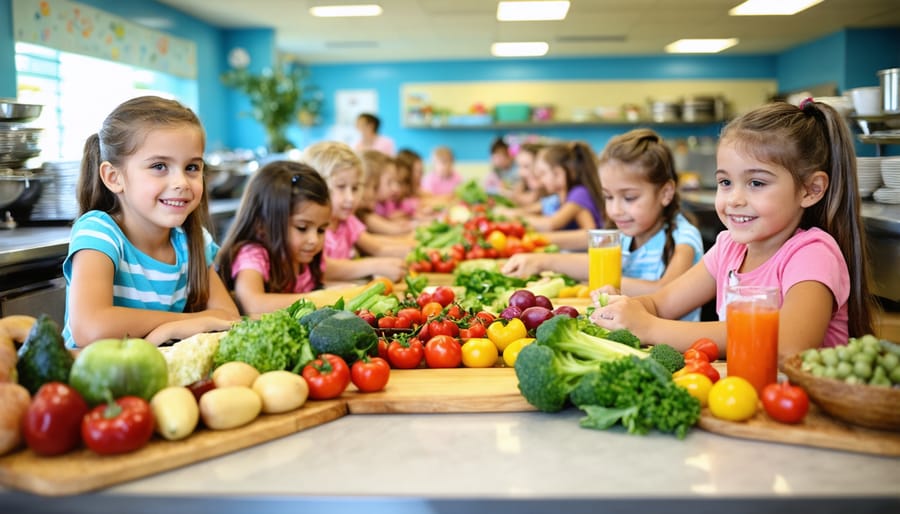Transform your family’s relationship with food by practicing nutritional mindfulness – a powerful approach that nurtures both physical health and your child’s mental well-being. When families eat together mindfully, they develop healthier eating habits, stronger emotional connections, and a deeper understanding of their body’s natural hunger and fullness signals.
Recent research shows that children who practice nutritional mindfulness are 60% more likely to maintain a balanced relationship with food throughout their lives. By focusing on the colors, textures, and flavors of each meal, rather than counting calories or restricting food groups, families create positive mealtime experiences that last a lifetime.
This science-backed approach combines traditional wisdom with modern nutritional science, offering practical tools for parents and educators to help children develop a healthy, sustainable relationship with food. Through simple daily practices like mindful meal planning, intentional eating environments, and guided food exploration, nutritional mindfulness transforms how we nourish our bodies and minds.
Let’s explore how this gentle, intuitive approach can revolutionize your family’s relationship with food, one mindful bite at a time.
What is Nutritional Mindfulness?
The Mind-Food Connection
The food our children eat does more than just fill their bellies – it plays a crucial role in their mood, behavior, and cognitive development. As Sarah Thompson, a pediatric nutritionist, often reminds us, “A well-nourished brain is a happy, focused brain.”
When children consume nutrient-rich foods, their bodies release feel-good chemicals that promote emotional stability and mental clarity. For instance, foods rich in omega-3 fatty acids, like salmon and walnuts, support brain function and can help reduce anxiety. Meanwhile, whole grains provide steady energy that helps maintain stable mood levels throughout the day.
On the flip side, processed foods and excess sugar can lead to energy crashes and mood swings. Many parents report noticeable changes in their children’s behavior after consuming sugary snacks or artificial additives. As one mom shared, “Since we switched to more whole foods, my son’s attention span has improved dramatically during homework time.”
Understanding this connection helps us make informed choices about our children’s nutrition, supporting both their physical and emotional wellbeing.

Beyond Just Healthy Eating
While traditional diets focus primarily on what to eat and what to avoid, nutritional mindfulness takes a more holistic approach to our relationship with food. Instead of counting calories or following strict rules, it encourages us to develop a deeper understanding of how food affects our bodies, minds, and emotions.
Think of nutritional mindfulness as having a friendly conversation with your body rather than giving it orders. It’s about noticing hunger cues, understanding emotional eating triggers, and recognizing how different foods make you feel. This approach helps children develop a positive, lasting relationship with food instead of viewing meals as a battle between “good” and “bad” choices.
Dr. Sarah Thompson, a pediatric nutritionist, explains, “When we teach children nutritional mindfulness, we’re not just helping them eat better – we’re giving them tools to understand their bodies and make conscious choices that serve their overall well-being.”
This broader perspective encourages families to consider the social and emotional aspects of eating, like enjoying meals together, celebrating cultural food traditions, and finding joy in preparing nutritious meals as a family.
Creating Mindful Eating Habits at Home
Family Mealtime Rituals
Family mealtimes offer precious opportunities to nurture both emotional connections and healthy eating habits. Creating positive mealtime rituals doesn’t require elaborate planning – it’s about fostering an environment where food and fellowship naturally come together.
Start by establishing regular meal schedules that work for your family. Whether it’s breakfast or dinner, consistency helps children feel secure and develops healthy eating patterns. Turn off phones, tablets, and televisions to eliminate distractions and encourage meaningful conversation.
Make the dining space welcoming by keeping the table clear of non-meal items and perhaps adding a simple centerpiece. Involve children in age-appropriate meal preparation tasks, like setting the table or helping to cook. This participation builds confidence and creates natural opportunities to discuss food choices and nutrition.
During meals, practice the art of mindful eating together. Take time to notice food colors, textures, and flavors. Share observations about the meal and express gratitude for the food and the people who prepared it. Ask open-ended questions about everyone’s day, creating space for genuine connection.
Remember that perfect behavior isn’t the goal – learning and growing together is. If mealtimes feel chaotic at first, start small. Even five minutes of focused family time can make a difference. Share family stories, cultural food traditions, or simply enjoy being present together.
For families with busy schedules, consider designating specific days for longer, more relaxed meals. These special occasions can become cherished traditions that children carry into their own families someday.
Create a judgment-free zone where food choices aren’t criticized, and bodies aren’t discussed negatively. This approach helps build a foundation for healthy relationships with both food and family.
Engaging Children in Food Choices
Involving children in food-related decisions and preparation creates powerful opportunities for teaching nutritional mindfulness while making lasting memories. When children participate in meal planning and cooking, they develop a deeper connection to their food and better understand the importance of balanced nutrition.
Start by inviting your child to join you during grocery shopping. Let them choose between healthy options, like picking which fruits they’d like for snacks or selecting colorful vegetables for dinner. This autonomy helps them feel more invested in their food choices while learning about different ingredients.
Make meal preparation a fun, educational experience. Even young children can help with simple tasks like washing vegetables, mixing ingredients, or setting the table. Older children can take on more responsibility, such as measuring ingredients or following simple recipes. During these activities, engage them in conversations about where food comes from, how different ingredients contribute to our health, and why variety matters.
Turn food awareness into a game by creating “rainbow plates” where children try to include as many different colored foods as possible. This naturally encourages them to choose diverse, nutrient-rich options. You can also start a small herb garden together, helping children understand the connection between growing food and eating well.
Remember to model mindful eating behaviors yourself. Children learn by example, so demonstrate taking time to enjoy meals, listening to hunger cues, and expressing gratitude for food. Avoid using food as a reward or punishment, as this can create unhealthy associations.
Keep the atmosphere positive and pressure-free. The goal is to foster curiosity and enjoyment around healthy eating, not to create stress or anxiety about food choices.

The Mental Health Benefits
Building a Healthy Food Relationship
Building a healthy relationship with food is like nurturing a lifelong friendship – it requires patience, understanding, and compassion. When we practice nutritional mindfulness, we learn to listen to our body’s natural hunger and fullness cues, rather than following rigid rules or restrictive diets that can lead to disordered eating patterns.
One powerful way to develop this relationship is through mindful eating practices. This means taking time to truly experience our meals, noticing the colors, textures, and flavors of our food, and eating without distractions like screens or work. When children learn these habits early, they’re better equipped to maintain a positive relationship with food throughout their lives.
It’s crucial to move away from labeling foods as “good” or “bad,” which can create unnecessary guilt and anxiety around eating. Instead, focus on variety and balance, teaching children that all foods can fit into a healthy lifestyle. This approach helps prevent the development of restrictive eating patterns and promotes a more peaceful relationship with food.
Body positivity plays a vital role in this journey. When we appreciate our bodies for what they can do rather than how they look, we’re more likely to make food choices that truly nourish us. Encourage children to focus on how different foods make them feel energized, satisfied, and strong, rather than their impact on appearance or weight.
Remember, building a healthy food relationship is a gradual process that looks different for everyone. The goal isn’t perfection but rather creating sustainable, enjoyable eating habits that support both physical and mental well-being.
Reducing Food-Related Anxiety
Food-related anxiety in children is a common concern that many parents face. Whether it’s fear of trying new foods, anxiety around mealtimes, or stress about eating in social situations, these challenges can impact both children and families. The good news is that mindfulness techniques can help create a more positive relationship with food.
Start by creating a calm, judgment-free eating environment. Turn off screens, sit together as a family when possible, and avoid pressuring children to “clean their plate.” Instead, encourage children to tune into their body’s hunger and fullness signals. Simple questions like “How does your tummy feel?” can help children develop this awareness.
One effective technique is the “exploring food” approach. Invite children to engage with new foods using all their senses – looking, smelling, touching, and listening – before tasting. This reduces pressure and makes the experience more playful and less threatening.
Remember that food anxiety often stems from a need for control. Involve children in meal planning and preparation when appropriate. This gives them a sense of agency and makes them more likely to try new foods on their terms.
If meal-related anxiety persists, consider keeping a mindful food journal together, noting not just what your child eats but also their feelings before, during, and after meals. This can help identify triggers and patterns while opening up conversations about food-related emotions.
Practice patience and consistency – changing food relationships takes time, but small steps lead to lasting progress.
Supporting Mindful Eating in Schools

Classroom Strategies
Implementing nutritional mindfulness in the classroom requires thoughtful planning and consistent execution. Start by designating a quiet corner where students can practice mindful eating during lunch periods. This space should be free from distractions like screens or loud conversations.
Create interactive activities that engage students with their food choices. For example, have students maintain a “gratitude food journal” where they record not just what they eat, but how different foods make them feel. This helps build awareness of the connection between food and emotions.
Incorporate sensory exploration exercises during nutrition lessons. Guide students through examining foods using all five senses – observing colors, smelling aromas, feeling textures, listening to sounds while chewing, and finally, tasting mindfully. This approach makes learning about nutrition more engaging and memorable.
Consider implementing “mindful moments” before lunch periods. A brief breathing exercise or guided meditation can help students transition from active learning to peaceful eating time. This practice also helps reduce rushed eating habits that often develop in busy school environments.
Partner with families by sending home simple mindful eating activities they can practice together. This reinforces classroom learning and creates consistency between school and home environments. Remember to celebrate small victories and maintain a positive, non-judgmental atmosphere as students develop these new habits.
Regular check-ins with students about their experiences can help track progress and adjust strategies as needed. Focus on creating an environment where students feel safe to explore their relationship with food without pressure or criticism.
Working with Parents
Creating a strong partnership between home and school is essential for nurturing mindful eating habits in children. When parents and educators work together, children receive consistent messages about healthy eating practices and develop a more positive relationship with food. This collaboration can be integrated into existing healthy development strategies that benefit children both at home and school.
Start by sharing information about your family’s food culture and any dietary considerations with your child’s teachers. This helps create a supportive environment that respects individual differences while promoting mindful eating. Consider joining parent-teacher meetings where you can discuss nutrition education and share ideas about incorporating mindful eating practices into both settings.
Regular communication through newsletters, apps, or informal chats can help maintain consistency in approaches to mealtimes. Share successful strategies that work at home, such as using positive language around food or practicing gratitude before meals. Similarly, ask teachers about their classroom practices so you can reinforce these at home.
Remember that children learn through observation. When parents and educators model mindful eating behaviors together during school events or parent participation days, it sends a powerful message about the importance of healthy food relationships. This unified approach helps children develop lasting habits that support both their physical and emotional well-being.
As we wrap up our exploration of nutritional mindfulness, remember that this journey is about progress, not perfection. By incorporating these mindful eating practices into your daily routines, you’re helping children develop a healthier relationship with food that can benefit them throughout their lives.
The key principles we’ve discussed – from creating a peaceful eating environment to practicing gratitude for our meals – work together to support both physical and emotional well-being. When children learn to listen to their bodies, appreciate their food, and understand the connection between nutrition and how they feel, they’re better equipped to make healthy choices independently.
Remember that you play a crucial role in modeling these behaviors. Children learn by example, and your own mindful eating practices can have a lasting impact on their relationship with food. Start small, perhaps with one mindful meal a day, and gradually build upon these practices as they become more natural for both you and the children in your care.
Don’t forget that setbacks are normal and part of the learning process. Celebrate small victories and maintain a positive, encouraging atmosphere around food and mealtimes. By implementing these nutritional mindfulness strategies consistently and compassionately, you’re helping to establish healthy habits that can last a lifetime.
Together, we can create a generation of children who approach eating with awareness, joy, and understanding, setting them up for a lifetime of better physical and mental health.


